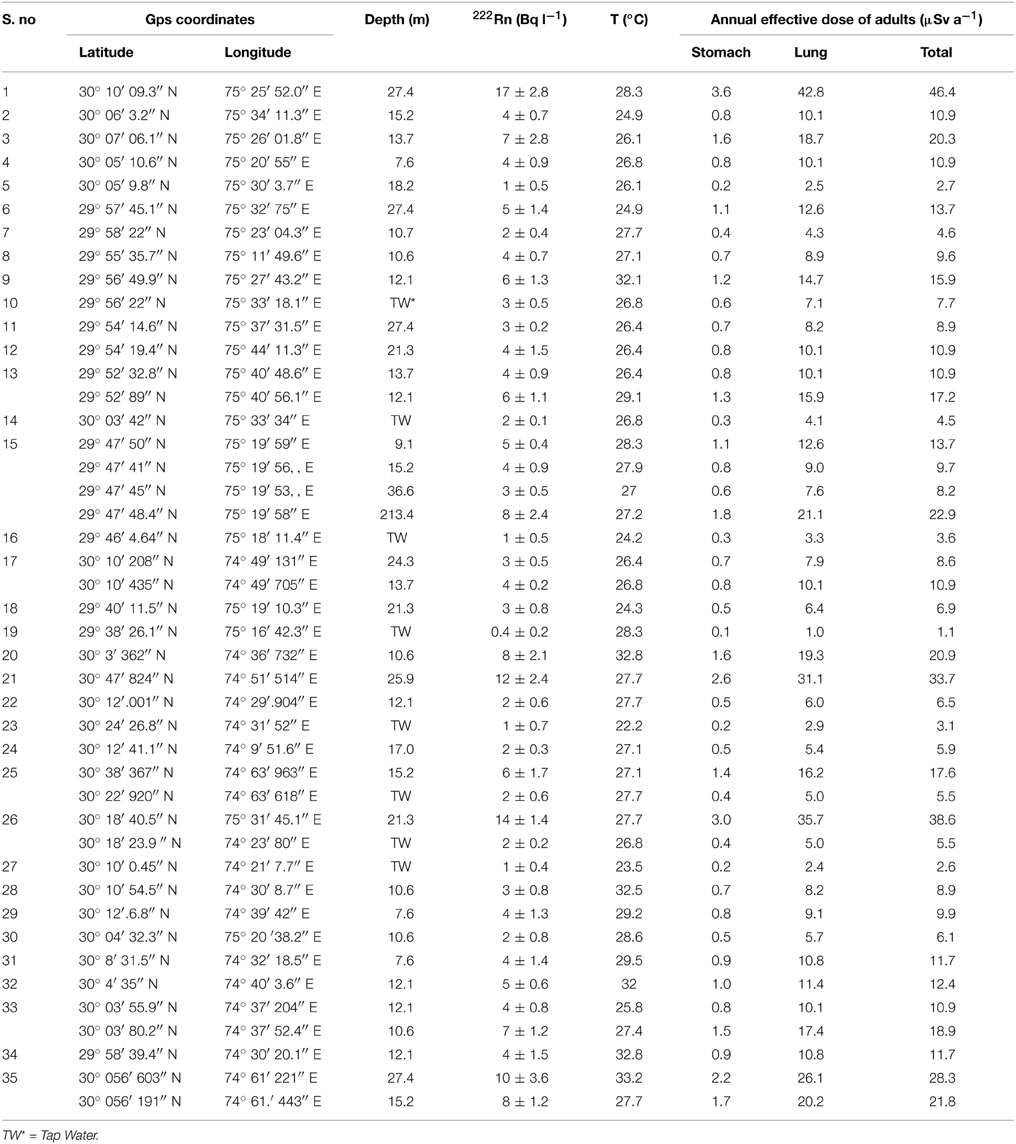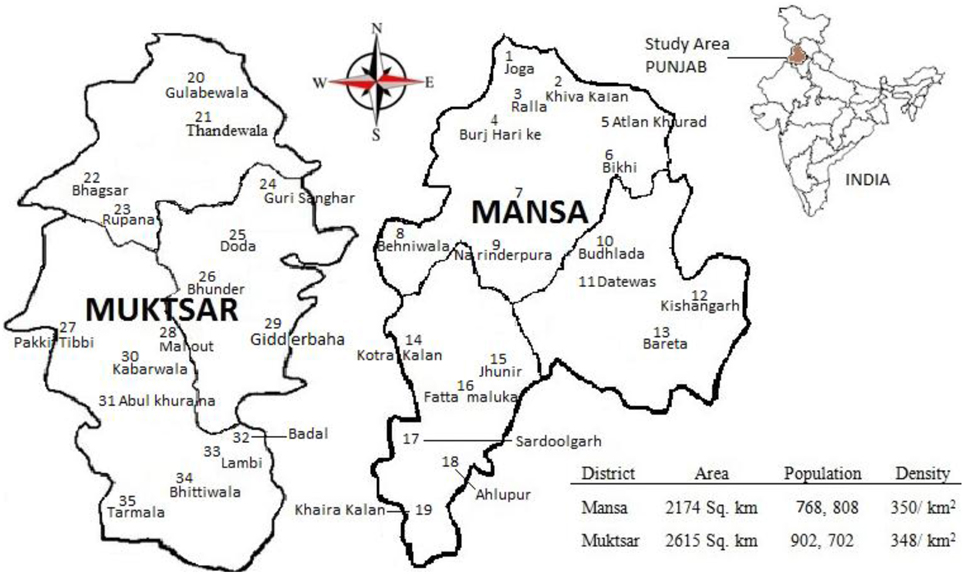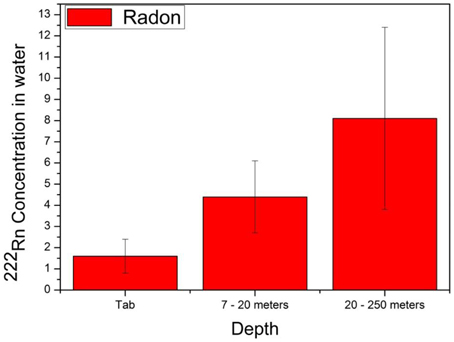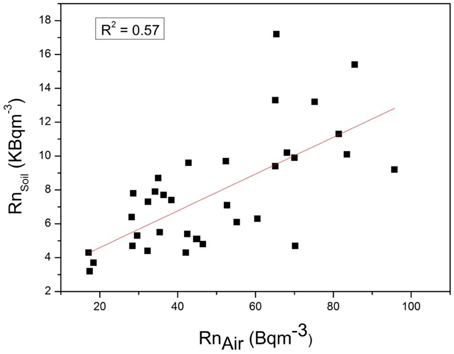222Rn and 220Rn levels of Mansa and Muktsar district of Punjab, India
- Department of Physics, Dr. B.R. Ambedkar National Institute of Technology, Jalandhar, India
In this study 222Rn (Radon) measurement were performed in water and soil gas and also both 222Rn and 220Rn concentrations were determined in air of Mansa and Muktsar district of Punjab, India. The data then used for calculation of the annual effective dose for health risk assessment of public. Totally 35 locations have been selected for the measurements. All measurements (222Rn and 220Rn) were done with RAD7 detection system. The 222Rn concentration in the water of studied area varies from 0.4 ± 0.2 Bq l−1 to 17 ± 2.8 Bq l−1. The average value of 222Rn concentration in soil, 222Rn and 220Rn concentrations in indoor air are 8 ± 3 kBq m−3, 47 ± 21 Bq m−3, and 39 ± 19 Bq m−3, respectively. The total average annual effective dose for water samples is 13 μSv a−1 and for indoor air samples is 2.3 mSv a−1. It has been observed that 222Rn concentration in water has increased with depth of groundwater.
Introduction
222Rn is a radioactive inert gas that is a decay product of radium in the naturally occurring uranium series. The measurement of 222Rn in the environment is of great interest due to its alpha emitting nature. A certain fraction of the 222Rn escapes into the air, where in the outdoors; it is quickly diluted and is of no further concern. However, in confined spaces such as homes and office buildings, 222Rn can accumulate to harmful levels. The main source of indoor 222Rn and 220Rn levels are the building material, soil and tap water. 222Rn monitoring in soil involves either measuring 222Rn in soil or measuring the 222Rn flux from a soil, but the former measurement is more easy and quick by using the active technique of 222Rn monitoring (Ruckerbauer and Winkler, 2001). 222Rn is responsible for about half of the radiation dose received by the general population (UNSCEAR, 1994). The inhalation of 222Rn and its progeny contributes more than 50% of the total dose from natural sources (UNSCEAR, 2000). A high value of the 222Rn concentration in the particular geological area can be health hazard and will be the cause of lung Cancer for the residents of that area (Sevc et al., 1976; Khan, 2000). The 222Rn from water contributes to the total inhalation risk associated with 222Rn in indoor air. The high values of 222Rn concentration in drinking water also lead to significant risk of stomach and gastrointestinal Cancer (Zhuo et al., 2001; Kendal and Smith, 2002).
As reported in earlier studies the concentration of Th, U, Pb, Cr, Ni, F and SO4 are higher than the permissible limits in soil of South western Punjab (Kochhar et al., 2006; Mehra, 2009), so a study has been carried out in the Mansa and Muktsar area to make assessment of 222Rn exposure for screening purpose and for investigating the geographical variation of the 222Rn concentration as well as for the health-related hazards of the locality if any. The main objective of this work is to assess the indoor 222Rn and 220Rn Concentrations, soil gas concentration, 222Rn concentration in water and the average annual effective dose to the population.
Geology
The scattered outcrops of the Aravali-Delhi Subgroup occur at Tosham (Haryana) just south of the study area i.e., Mansa and Muktsar districts as shown in Figure 1. The soil in the study area falls in the arid and moisture regime. The soils associated with alluvial planes shows better indurations and mature development of soil profile. They are composed of different layers of clay, sticky clay and fine to coarse grained micaceous sandstone (Kochhar et al., 2006).
Experimental Setup
An active technique RAD-7 in different modes has been used to measure the 222Rn and 220Rn concentration in air, water and soil of 35 locations in vicinity of Mansa and Muktsar districts of Punjab, India.
222Rn and 220Rn Measurement in Air
The measurement of 222Rn and 220Rn concentration in indoor air has been taken using RAD7 air accessories for continues 48 h protocol. EPA test protocols have been used for operating the RAD7 in indoor air (USEPA, 1993). The doors and windows of the houses were closed for at least 12 h before the measurement of 222Rn and 220Rn in air. The detector has an ability to distinguish alpha particles from 218Po and 214Po with energies of 6.0 and 7.9 MeV. RAD7 can measure the 222Rn concentration > 0.4 Bq m−3 and < 750,000 Bq m−3.
222Rn Measurement in Water
The sampling locations of studied area have been chosen with great care and an attempt has been made to cover most of the area of study region. The in situ measurement of water samples was made using RAD- H2O accessories. The RAD- H2O uses a standard pre-calibrated degassing system and preset protocols, built into the RAD-7 which gives direct reading of 222Rn concentration in water. A 250 ml vial has been used to collect the samples of water from various locations. A Wat– 250 protocol and grab mode with 5 min cycle and four recycles have been used to run the instrument for the estimation of 222Rn in Water. The water samples have been collected from each village by varying the depth of ground water, surface water and tap water.
Soil Gas Measurement
For analysis of 222Rn concentration in soil gas the measurements were done in same 35 locations and four measurements were done at each location. The pilot rod has been hammered into the ground to the depth required for sampling. Once the rod has been successfully driven to the required depth, the pilot rod has been removed for the penetration of drive rod along with probe more easily to sampling site. The drive rod has been positioned inside the probe and continuously hammered the rods together into the sampling site. When drive rod along with probe has come to be required depth then removed the drive rod from the sampling site and connects the probe with RAD7 soil accessories for sucking the soil gas from deep soil. The soil gas sucked through the tube pipe into the measuring instrument for 5 min. The gab mode and sniff protocol were used for the soil gas sampling on the measuring instrument at each site. The measurement of 222Rn and 220Rn concentration in indoor air has been taken using RAD7 air accessories for continues 48 h protocol. EPA test protocols have been used for operating the RAD7 in indoor air (USEPA, 1993).
Theoretical Formalism
The ingestion, inhalation and annual effective dose have been calculated by Equations (1) and (2) (UNSCEAR, 2000).
Where EWIg is the effective dose for ingestion, CRnW is 222Rn concentration in water (kBq m−3) and Cw is weighted estimate of water consumption (60 la−1), respectively and EDC is the effective dose coefficient for ingestion 3.5 nSv Bq−1.
where EWIh is the effective dose for inhalation, RaW is the ratio of 222Rn in air to 222Rn in tap water (10−4), F(Rn) is the equilibrium factor (0.4) between 222Rn and its decay products, O is the average indoor occupancy time per person (7000 h y−1) and DCFR is the dose conversion factor for 222Rn exposure 9 nSv h−1 (Bq m−3)−1. The average annual effective dose for indoor 222Rn is calculated by Equations (3) and (4) using parameters introduced in report by UNSCEAR (2008).
Where AEDR (mSva−1) is annual the effective dose for 222Rn, 222Rnair is the indoor 222Rn concentration (Bq m−3) and remaining factors have been explained above.
Where AEDT(mSva−1) is the annual effective dose for 220Rn, 220Rnair is the indoor 220Rn concentration (Bq m−3), DCFR is the dose conversion factor for 222Rn exposure 40 nSv h−1(Bq m−3)−1 and F(Th) is the equilibrium factor (0.1) between 220Rn and its decay products UNSCEAR (2008).
The daughter concentration of 222Rn and 220Rn in terms of Potential Alpha Energy Concentration (PAEC) in mWL has been calculated using Equation (5).
Results and Discussion
Table 1 summarizes the results of measurement of 222Rn concentration in collected water samples of 35 villages. The 222Rn concentration in water samples of studied area varies from 0.4 ± 0.2 Bq l−1 to 16.7 ± 2.8 Bq l−1 with an average value of 4.7 Bq l−1, which is lower than the recommended value of USEPA (1991). The USEPA recommended the maximum contamination level (MCL) for 222Rn concentration in water as 11 Bql−1 (USEPA, 1991). The measured values of 222Rn in water of studied area are well within the safe limit of 4–40 Bq l−1 (UNSCEAR, 2008).

Table 1. Average 222Rn concentration data and annual effective dose of different water sources in Mansa and Muktsar Districts of Punjab.
The 222Rn concentration in water is lower as compared to higher value of uranium content in the nearby region of the studied area (Kochhar et al., 2006). It may be because of the solubility of 222Rn in water is relatively low and with its short radio-active half life much of it will decay before it has opportunity of release from the ground water. When 222Rn-containing groundwater reaches the surface by natural or man-made forces, the 222Rn will inevitably be out gassed into the atmosphere. In some villages, the samples of ground water have been collected from different depth of ground water and tap water. It has been observed that 222Rn concentration in water has increased with depth of groundwater (Figure 2). The level of 222Rn concentration in tab water has been found to be lower than the level of 222Rn concentration in ground water. Tab water is actually stored ground water and 222Rn gas escapes out when it stored. This may be due to the surface water typically containing very low concentrations of 222Rn, with activities below 4 Bq l−1 (Hopke et al., 2000). However, concentrations of 222Rn in ground water may be high, depending on the aquifer or hydrogeology of the region. In most of the cases the ground water concentration is higher than the tap water. The increase in the value of 222Rn concentration in water with depth has been reported by many researchers as given in Table 2.

Table 2. The comparison of mean 222Rn concentrations in indoor air, water, and soil gas samples from different countries.
The 222Rn in the drinking water is the main source of the radiation doses for stomach (Ingestion dose) and lungs (Inhalation dose). The ingestion and inhalation doses in the studied area vary from 0.1 μSva−1 to 3.6 μSv a−1 and 1.0 μSva−1 to 42.8 μSv a−1 and are less the worldwide average annual of Inhalation (1.26 mSv a−1) and Ingestion (0.29 mSv a−1) recommended by UNSCEAR (2008). The total average annual effective dose for 222Rn in water is 13 μSva−1. The annual effective dose of 0.1 mSv a−1 is the safe limit of drinking water from three radioisotopes viz. 222Rn, 3H, and 40K recommended by European Commission and world health organization (European Commission, 1998; WHO, 2004).
It can be seen from Table 3 that the average Value of indoor 222Rn and220Rn concentration in the vicinity of these districts are 47 ± 21 Bq m−3 and 39 ± 19 Bq m−3, respectively. These values are within the range of intervention level (200–300 Bq m−3) recommended by International commission on Radiological Protection (ICRP, 2009). The present average indoor 222Rn values are lower in comparison to the values reported in USA, China, Brazil, Kenya and Uttrakhand region of India but greater than Muree region of Pakistan as reported in Table 2.

Table 3. Statistical Parameters of 222Rn and 220Rn concentration in indoor air samples, 222Rn concentration in soil samples.
The ratio of PAEC of 220Rn to that of 222Rn is in the range of 0.06–0.46. Stranden and Dixon have reported measurements on a variety of underground mines and enclosures in Norway and UK (Dixon et al., 1985; Stranden, 1985). The estimated ratios of PAEC (220Rn)/PAEC (222Rn) are usually within the range of 0.1–1.0. The AEDR (mSv a−1) and AEDT (mSv a−1) in the studied area are varied from 0.4 mSv a−1 to 2.4 mSv a−1 and 0.3 mSv a−1 to 2.3 mSv a−1, respectively. In all the villages studied, the average AEDR (mSv a−1) was 1.24 mSva−1 which is slightly less than the worldwide average annual dose (1.26 mSv a−1) recommended by UNSCEAR (2008). The 222Rn concentration in soil of studied area has been varied from 3.2 kBq m−3 to 17.2 kBq m−3. Figure 3 shows the correlation coefficient for measured 222Rn concentration in air (Rnair) and soil (Rnsoil). It has been found that a positive correlation (R2 = 0.57) exits between 222Rn concentration in air and soil gas. The value of 222Rn concentration in soil is lower than the values reported in USA, Islamabad region of Pakistan and almost equivalent to china as given in Table 2. Using student's t–distribution with 95% confidence limit as shown in Equation (6).
Where σ is the standard deviation, m is arithmetic mean and (n - 1) is degree of freedom. The calculated 95% confidence limits for 222Rn and 220Rn in indoor air is 33.3–4.2 Bq m−3 and 48.9–54.9 Bq m−3, respectively. The calculated 95% confidence limits for 222Rn in soil and water are 6.8–8.7 kBq m−3 and 3.8–5.6 Bq l−1, respectively.
Conclusion
It has been seen that 222Rn concentration in water samples are well below the recommended value. The total average annual effective dose for 222Rn in water is lower than reference level (0.1 mSv a−1) recommended by EC and WHO organization (European Commission, 1998; WHO, 2004). It is observed that there is a positive correlation between 222Rn concentration in air and soil, so the soil of the study area has significant contribution to the indoor 222Rn concentration. The average Indoor values of 222Rn and 220Rn concentration in the studied areas are greater than the world average value of 40 Bq m−3 (UNSCEAR, 2000), but the values are in general within the range of recommended action level 200–300 Bq m−3 (ICRP, 2009). The estimated ratios of PAEC (220Rn)/PAEC (222Rn) are usually within the range of 0.1–1.0. The average annual effective dose in indoor air received by the residents of the study area is lower than the recommended action level of 1.26 mSv a−1 (UNSCEAR, 2008).
Conflict of Interest Statement
The authors declare that the research was conducted in the absence of any commercial or financial relationships that could be construed as a potential conflict of interest.
Acknowledgments
The authors are grateful to the Director of NIT, Jalandhar for their necessary support and facility in carrying out the experimental work and Special thanks to BRNS for their financial support under project 2011/36/28 BRNS.
References
Ali, N., Khan, E. U., Akhter, P., Khan, F., and Waheed, A. (2010). Estimation of mean annual effective dose through radon concentration in the water and indoor air of Islamabad and Murree. Radiat. Prot. Dosim. 141, 183–191. doi: 10.1093/rpd/ncq160
Choubey, V. M., Bartarya, S. K., Negi, M. S., and Ramola, R. C. (2003). Measurement of Radon and thoron concentration in atmosphere and drinking water of eastern doon valley, India. Indoor Built Environ. 12, 191–196. doi: 10.1177/1420326X03012003007
Colmenero Sujo, L., Montero Cabrera, M. E., Villalba, L., Rentería Villalobos, M., Torres Moye, E., García León, M., et al. (2004). Uranium-238 and thorium-232 series concentrations in soil, radon-222 indoor and drinking water concentration and dose assessment in the city of Aldama, Chiuahua, Mexico. J. Environ. Radioact. 77, 205–219. doi: 10.1016/j.jenvrad.2004.03.008
Dixon, D. W., James, A. C., Strong, J. C., and Wrixon, A. D. (1985). A Review of all Sources of Exposure to Natural Radiation in UK Mines. Radiation Safety in Mining. Toronto, ON: Canadian Nuclear Association.
European Commission. (1998). On the Quality of Water Intended for Human Consumption. Official Journal of the European Commission. Directive 98/83/EC, Official J L 330.
Hopke, P. K., Borak, T. B., Doull, J., Cleaver, J. E., Eckerman, K. F., Gundersen, L. C. S., et al. (2000). Health risks due to radon in drinking water. Environ. Sci. Technol. 34, 921–926.
ICRP (International Commission on Radiological Protection). (2009). International Commission on Radiological Protection Statement on Radon. ICRP Ref. 00/902/09.
Kendal, G. M., and Smith, T. J. (2002). Dose to organs and tissues from radon and its decay products. J. Radiol. Prot. 22, 389–406. doi: 10.1088/0952-4746/22/4/304.
Khan, A. J. (2000). A study of indoor radon levels in Indian dwellings, influencing factors and lung cancer risks. Radiat. Meas. 32, 87–92. doi: 10.1016/S1350-4487(99)00275-9
King, C. Y., and Minissale, A. (1994). Seasonal variability of soil-gas radon concentration in central California. Radiat. Meas. 23, 683–692. doi: 10.1016/1350-4487(94)90004-3
Kochhar, N., Gill, G. S., Tuli, N., Dadwal, V., and Balaram, V. (2006). Chemical quality of ground water in relation to incidence of cancer in parts of SW Punjab, India. Asian J. Water Environ. Pollut. 4, 107–112.
Magalhaes, M. H., Amaral, E. C. S., Sachett, I., and Rochedo, E. R. R. (2003). Radon-222 in Brazil: an outline of indoor and outdoor measurements. J. Environ. Radioactiv. 67, 131–143. doi: 10.1016/S0265-931X(02)00175-3
Marques, A. L., Dos Santos, W., and Geraldo, L. P. (2004). Direct measurement of Radon activity in water from natural sources using nuclear track detector. Appl. Radiat. Isotopes 60, 801–804. doi: 10.1016/j.apradiso.2004.01.015
Mehra, R. (2009). Use of gamma ray spectroscopy measurements for assessment of the average effective dose from the analysis of 226Ra, 232Th, and 40 K in soil samples. Indoor Built Environ. 18, 270–275. doi: 10.1177/1420326X09104140
Mustapha, A. O., Patel, J. P., and Rathore, I. V. S. (2002). Preliminary report on radon concentration in drinking water and indoor air in Kenya. Environ. Geochem. Health 24, 387–396. doi: 10.1023/A:1020550103471
Prasad, G., Prasad, Y., Gusain, G. S., and Romala, R. C. (2008). Measurement of radon and thoron levels in soil, water and indoor atmosphere of Budhakedar in Garhwal Himalaya, India. Radiat. Meas. 43, 375–379. doi: 10.1016/j.radmeas.2008.04.050
Ruckerbauer, F., and Winkler, R. (2001). Radon concentration in soil gas: a comparison of methods. Appl. Radiat. Isotopes 55, 273–280. doi: 10.1016/S0969-8043(00)00389-4
Sevc, J., Kunz, E., and Placek, V. (1976). Lung cancer in uranium miners and long term exposure to radon daughter products. Health Phys. 30, 433–437.
Stranden, E. (1985). Thoron Daughter to Radon Daughter Ratio in Mines. Occupational Radiation Safety in Mining, Toronto, ON: Canadian Nuclear Association.
Sun, K., Guo, Q., and Jianping, C. (2004). The effect of some soil characteristics on soil radon concentration and radon exhalation from soil surface. J. Nuclear Sci. Technol. 41, 1113–1117. doi: 10.1080/18811248.2004.9726337
UNSCEAR (United Nations Scientific Committee on the Effects of Atomic Radiation). (1994). Ionizing radiation: Sources and Biological Effects.
UNSCEAR (United Nations Scientific Committee on the Effect of Atomic Radiation). (2000). Exposure Due to Natural Radiation Sources.
UNSCEAR (United Nations Scientific Committee on the Effect of Atomic Radiation). (2008). Sources and Effects of Ionizing Radiation.
USEPA (1991). National Primary Drinking Water Regulations for Radionuclides. Governmental Printing Office.
USEPA (1993). Indoor Radon and Radon Decay Product Measurement Device Protocols. Office of Air and Radiation.
Xinwei, L. (2006). Analysis of radon concentration in drinking water in Baoji (China) and the associated health effects. Radiat. Prot. Dosim. 121, 452–455. doi: 10.1093/rpd/ncl048
Zhuo, W., Iida, T., and Yang, X. (2001). Occurrence of 222Rn,226Ra,228Ra and U in groundwater in Fujain province. Chin. J. Environ. Radioact. 53, 111–120. doi: 10.1016/S0265-931X(00)00108-9
Keywords: 222Rn (radon), 220Rn (thoron), ingestion, inhalation, annual effective dose, PAEC
Citation: Mehra R, Bangotra P and Kaur K (2015) 222Rn and 220Rn levels of Mansa and Muktsar district of Punjab, India. Front. Environ. Sci. 3:37. doi: 10.3389/fenvs.2015.00037
Received: 19 January 2015; Accepted: 24 April 2015;
Published: 18 May 2015.
Edited by:
Anna Cook Jeng, Old Dominion University, USAReviewed by:
Mutlu Içhedef, Ege University Institute of Nuclear Sciences, TurkeyEfstratios Vogiannis, Evangeliki Model School of Smyrna - Athens, Greece
Copyright © 2015 Mehra, Bangotra and Kaur. This is an open-access article distributed under the terms of the Creative Commons Attribution License (CC BY). The use, distribution or reproduction in other forums is permitted, provided the original author(s) or licensor are credited and that the original publication in this journal is cited, in accordance with accepted academic practice. No use, distribution or reproduction is permitted which does not comply with these terms.
*Correspondence: Rohit Mehra, Department of Physics, Dr. B. R. Ambedkar National Institute of Technology, Jalandhar, India, mehrar@nitj.ac.in
 Rohit Mehra
Rohit Mehra Pargin Bangotra
Pargin Bangotra Kirandeep Kaur
Kirandeep Kaur

